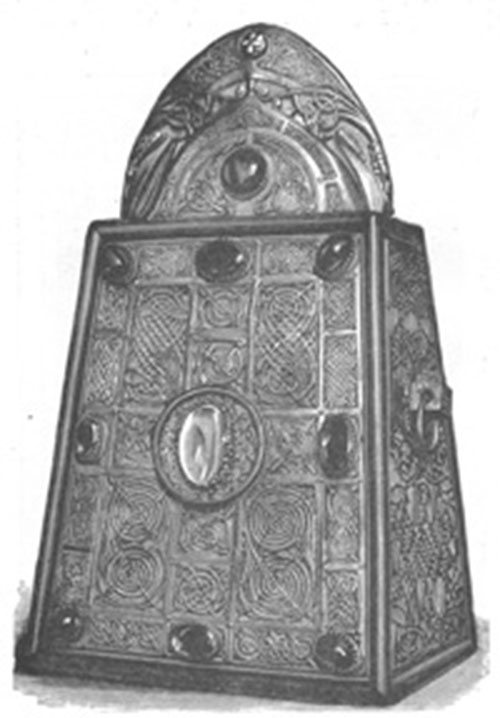Shrine of St. Patrick's Bell - Irish Pictures (1888)
From Irish Pictures Drawn with Pen and Pencil (1888) by Richard Lovett
Chapter 1: Ireland’s Eye … continued
« Previous Page | Start of Chapter | Book Contents | Next Page »
In addition to the Domnach Airgid, the Museum possesses another relic which there is good reason for believing dates from the time of St. Patrick, viz., his bell. 'The iron bell of St. Patrick is at once the most authentic and the oldest Irish relic of Christian metal work that has descended to us. It possesses the singular merit of having an unbroken history through 1400 years. This bell is quadrilateral, and is formed of two plates of sheet iron which are bent over so as to meet, and are fastened together by large-headed iron rivets. The corners are rounded by a gentle inclination of the parts which join. One of the plates constitutes the face, the crown and the upper third of the back, as well as the adjacent portion of each side, being doubled over at the top, and descending to meet the smaller plate, which overlaps it at the junction. Subsequently to the securing the joints by rivets, the iron frame was consolidated by the fusion of bronze into the joints and over the surface, giving to the whole a metallic solidity which very much enhanced its resonance, as well as contributed to its preservation. The handle is of iron, let in by projecting spikes to perforations on the ridge of the bell, and further secured on the outside by bronze attachments of its straps.'[9]
This bell belongs to a class of ecclesiastical objects of which numerous specimens have come down to us. Over fifty are extant in Ireland, and they are not uncommon in Wales and Scotland. In the case of St. Patrick's Bell the history can be clearly traced. About the eleventh century it became the custom, out of reverence for the early Christian teachers, to prepare costly and richly jewelled cases or shrines for these bells. We give an engraving of that in which St. Patrick's Bell was for many centuries enshrined. It is a splendid example of goldsmith's work, and it was made between 1091 and 1103, when Donell MacAulay, the name found in the inscription upon it, was Archbishop of Armagh. It is of brass, upon which silver-gilt plates are fastened, and fine gold filigree work; it is adorned with gems and crystal. 'Since it was made, about 1091, it has never been lost sight of. From the beginning it had a special keeper; in succeeding generations its custody was continued in the same family, and proved to them a source of considerable emolument, and in after ages, when its profits ceased to accrue, long association so bound it up with the affections of the keeper's family that they almost held their existence upon the tenure of its safe custody, and then handed it down from generation to generation, till the stock at last became extinct, and the object of their former care passed into a keeping established by friendship instead of blood.'[10]
From the beginning of the twelfth century until about the commencement of the present, the bell and its shrine was in the custody of a family named Mulholland. The last representative of this family, being childless, entrusted them to the care of the late Adam McLean, Esq., of Belfast. They then passed into the possession of Dr. Todd, from whose executor they were purchased for the Academy for the sum of £500.
NOTES
[9] Transactions of the Royal Irish Academy, 1877.
[10] Early Christian Art in Ireland, p. 59.
« Previous Page | Start of Chapter | Book Contents | Next Page »

